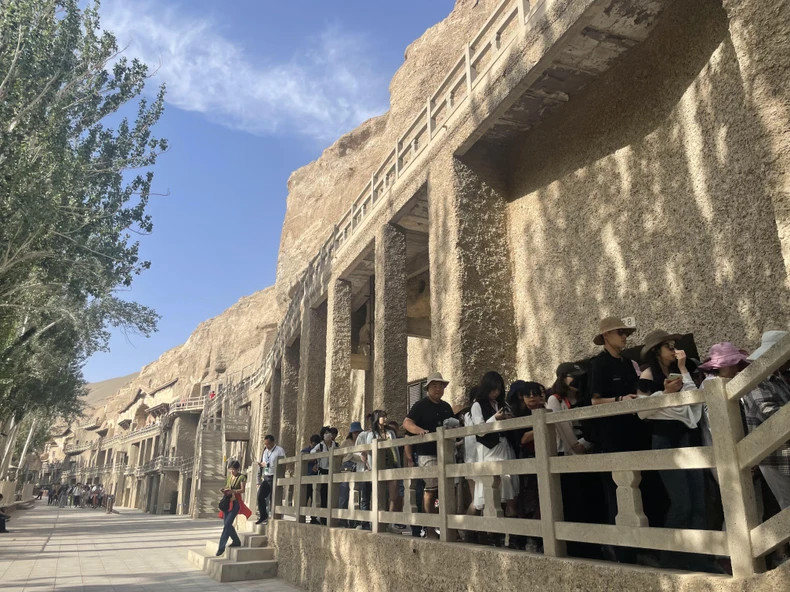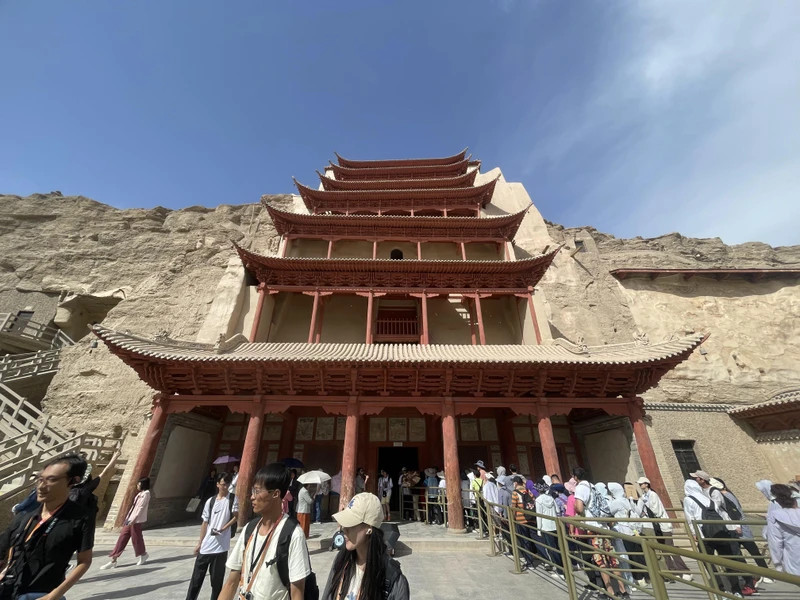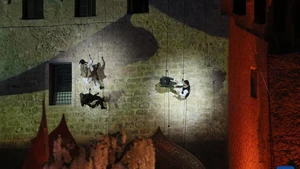The historic Silk Road started from Chang'an and stretched to Constantinople. This was the gateway for trade, political, economic and cultural exchanges between the two continents of Asia and Europe. On this legendary road, merchants often stopped at Dunhuang in Gansu Province to exchange for healthy camels, food and guards for the dangerous journey through the Taklamakan Desert. Before leaving Dunhuang, they often prayed for a safe trip at the Mogao Caves and when they returned, they would give sincere thanks to heaven and earth at the caves.
 |
| The Mogao Caves were listed by UNESCO as a World Heritage Site in 1987. |
Legend has it that there was a begging monk named Le Sun. One moonlit night, he saw thousands of Buddhas shining in the sky above Mingsha Mountain. He carved a cave to meditate beside the marble cliffs, later known as the Mogao Caves. He and his disciples drew paintings of Buddhas and their daily lives on the walls and ceilings of the cave. Later, another monk named Fa Liang visited Dunhuang and created a second cave.
Within a few decades, 70 caves were carved in Mogao. For 1,000 years, artists created more than 735 temples in the caves, with 45,000 square metres of murals. There are about 2,415 statues still standing in Dunhuang, many of which were restored during the Qing Dynasty. In previous dynasties, the backs of the statues were attached to the walls, while the heads were made separately and then placed on the bodies. It was not until the Tang Dynasty that the statues were completely detached. The caves created during the Tang Dynasty are considered the pinnacle of Mogao architecture. The size of some sculptures is astonishing. In one cave, there is a 23-metre-tall Buddha statue carved from stone.
As the largest cluster of caves in China, the Mogao Caves are Dunhuang's cultural and artistic centre with a mysterious atmosphere. Those who come to the Mogao Caves are fascinated by the ceilings decorated with solemn but attractive paintings. Therefore, Dunhuang not only developed extremely prosperous trade but also contributed to the foundation for the development of arts, leaving its mark on the glorious art history of this land. By 1400, when maritime routes replaced the Silk Road, Dunhuang was gradually forgotten. The sand desert caused some caves to be destroyed or damaged, but some have been preserved.
Talking about Dunhuang, it is impossible not to mention the giant Mingsha sand mountain in the south of the city. This mountain range is 40km long along the Silk Road, with the highest peak at 1,715 metres above sea level. Mingsha was named one of China’s five most beautiful deserts in 1994.
 |
| Oasis in the Mingsha Sand Mountain. |
Crescent Moon Lake is a crescent-shaped lake located in an oasis in Mingsha. Crescent Moon Lake is estimated to be about 2,000 years old, 218 metres long and 54 metres wide, containing clear blue water like jade. For centuries, this place has been likened to a lake in the desert or the charming mouth of a beautiful woman.
Gao Nana, a tour guide in Dunhuang, said this lake was named Crescent Moon Lake during the Qing Dynasty. After thousands of years, despite being in the middle of a burning sand desert, the lake has not been covered by sand and its water has been clear all year round. Legend has it that the water in the lake has never been polluted by sandstorms or dried up.
Sitting by the lake on a sunny summer afternoon and looking at the blue sky mixed with water, visitors will feel very relaxed.
Known as the “lord of the desert”, the Bactrian camel is the best means of transport in the sand desert. More than 1,000 Bactrian camels and hundreds of people work as camel guides or photographers for tourists in the desert at the Mingsha Sand Mountain. Each group of five Bactrian camels is led by a guide who takes tourists on the 4km journey deep into the sand desert.
Herds of camels following each other on the Mingsha Sand Mountain remind me of the image of merchants carrying heavy goods and travelling on the road connecting Eastern China through Central Asia, to the Mediterranean thousands of years ago. On the back of camels, Mingsha Sand Mountain appears like a majestic sand painting with natural dunes of all shapes, stretching for thousands of miles of desert. Riding a camel in the vast sandstorm of the Gobi Desert will be a memorable experience for any visitor.
















